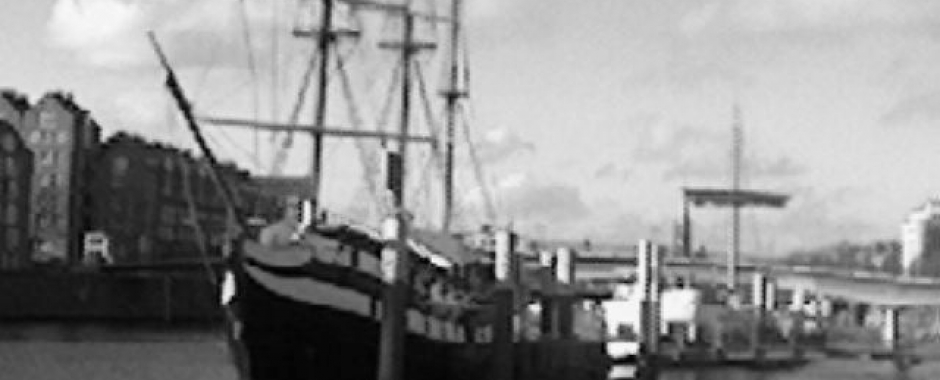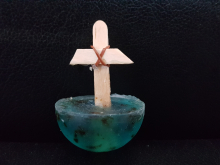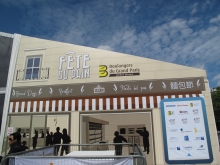
Across the North sea, the oversea trade merchants (Hanse) formed the guilds from the north of German towns. A major port on the Weser river is Bremerhaven. Bremen is a commercial and industrial city at the south of the Weser. Many international companies have their headquarters here.
One of the well known chocolate company, Hachez, has the factory and shop in the city center. The first merchant hall to accommodate and protect the foreign merchants is called "Schuetting". It may sound like English word "Shooting", but it is from the German word "Schuetzen" = protect.
As "Schuetting" was a guild house at the market square in Bremen, the first coffee house opened in 1673 and a traditional gentlemen's club at the basement (Keller) of this building:
Bremen is also known to be the town musicians. According to the Grimm Brother's fairy tale book, they are the donkey, dog, cat and rooster:
It is located near the entrance to a well known Ratskeller or Wine cellar:
One of the most important social events is wine tasting and drinking rare and expensive wines at this place. It is located at the underground of Rathaus or City hall of Bremen:
In front of this Bremen city hall, many tourists visited "Roland":
The city's protector, "Roland", the figure was made of wood and destroyed in 1366 by Bederkesa (a group of people in lower Saxony). The city replaced the current "Roland" with limestone in 1404. Interestingly, since then it has never been destroyed although many wars occured. ( Read our article about Roland: Prince Biscuit )
It stands at the market square as if it protects the city and the church. The Bremen cathedral or St. Peter's cathedral is connected to the concert hall in Art Deco style, designed by Walter Görig:
The name "Glocke" means bell as the building was in octagonal bell shape. It was rebuilt after the fire in 1915. Near the market square, one of the most touristic attractions called " Böttcher Strasse". The building no.4 with 30 porcelain bells is the Glockenspiel House:
In general, The carillon chimes at noon, 3 pm and 6 pm from January to March, otherwise it chimes every hour from noon to 6 pm.
It is the place for artists to look at the "Die entartete Kunst" = Degenerate Art exhibition. Gothic and Art Nouveau mixed style of buildings are presented along the narrow street:
Robinso Crusoe house is located on this street and built by a rich coffee merchant who admired his adventure fiction books:
A typical saxony brick building with flemish stepped gable, facade and windows of Robinson Crusoe house and the opposite side of the narrow street is the Atlantis house. Both have the same character of Late Gothic and Renaissance style. From this street view, it looks as if it belongs together. (Both have the half arch connected to a column of each building)
The next quarter is "Schnoor":
This area is preserved to have the character of medieval center. Many shops sell handicrafts for ships and accessories such as ropes and cables. (Schiffer Haus on the right, Schiff= ship)It was a harbour in the middle ages which was considered to be the poor area. Nowadays, fishermen did not live there, they sold their lands or turned to be restaurant owners as the price of land goes up radically. There are many dishes that are considered to be a local food from northern Germany (not only in Bremen) such as Labskaus (corned beef with pickled herring, gherkin and beetroot). The typical known food from Bremen is the wedding soup:
The local dessert in Bremen is called " Rote Gruetze":
"Rote Gruetze" means "Rough Red" (mixed berries, traditional recipe: Sour cherries, Rasberries, red and blackcurrants). Some recipes can be with blackberries or other combinations that are available. It is usually served with vanilla cream, yogurt or pudding on the plate or bowl:
You will find this dessert in all restaurants and coffee shops in Bremen:
Cafe am Schnoor is a nice place to visit as well as the famous Beck's restaurant, located at "Am Schnoor":
The word "Schnoor" means String. The fishermen lived and built their cottages on the Island in the middle of the river Weser (The river that splited to the city center is now called "Balge"). The first habour started from the north bank of Balge and the settlement expanded along the road called "Langenstrasse" = long street. Around the 13th, the new port "Schlachte" was built on the other side ( Schachte = the river bank reinforcement with wooden panels of the main Weser). Both habours were used until the 16th.
During that time, there were many travelers and missionaries, here is the place for pilgrims. An interesting historical building in the old town district, between Tiefer street and Schnoor, a man dressing in middle ages style stands in front of the building with greeting texts on the panel above the door. When you look up, you will see St. Jacobus Major (the saint of the pilgrims):
This saint is told to bring luck to the sailors and travelers. The one who wears seashell is pilgrimer. (a seashell is called "Jakobsmuschel" = a symbol of the pilgrims as it has the name of this saint.)
Have a safe journey to the "Weser"!


























